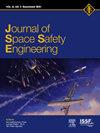Study and evaluation of tether-net parameters for space debris capture using modified capture quality index
IF 1.7
Q3 ENGINEERING, AEROSPACE
引用次数: 0
Abstract
The increasing volume of space debris presents a significant threat to spacecraft safety and the long-term viability of space missions. Among the proposed methods for capturing and removing small space debris at low relative velocities, the tether-net method emerges as particularly promising. Identifying and evaluating the parameters influencing the capture process through simulations is imperative to ensure the effective capture of debris by the net and to assess its efficiency. Therefore this study investigates the influence and effectiveness of various parameter combinations through simulations. The study examines the effects of parameters such as net and space debris masses, shooting speed of the corner mass (CM), CM ejection angle, and activation or deactivation of the net mouth closure mechanism on the space debris-capturing capacity. The capture effectiveness evaluation was conducted utilizing the modified capture quality index (). During simulations where the closure mechanism was not activated, the net opened upon debris contact, resulting in expulsion and decreased . Conversely, activation of the closure mechanism enhanced the probability of capturing space debris. Within the “wrap” category, parameter combinations of medium CM ejection angles, extended initial distances, and high shooting speeds yielded the highest capture quality for debris capture, as confirmed by the . Conversely, a larger CM ejection angle and other parameters reduced the likelihood of debris capture, indicating an inverse relationship between the ejection angle and the initial distance between the net and the debris.
基于改进捕获质量指数的空间碎片捕获系绳网参数研究与评价
空间碎片数量的增加对航天器安全和空间任务的长期可行性构成重大威胁。在以低相对速度捕获和清除小空间碎片的拟议方法中,系绳网方法显得特别有前途。通过模拟识别和评估影响捕获过程的参数是确保网有效捕获碎片和评估其效率的必要条件。因此,本研究通过仿真研究了各种参数组合的影响和有效性。研究考察了网块和空间碎片质量、角块射击速度、角块弹射角以及网口关闭机制的激活或停用等参数对空间碎片捕获能力的影响。利用改进的捕获质量指数(MCQI)对捕获效果进行评价。在没有启动关闭机制的模拟中,网在碎片接触时打开,导致驱逐并降低MCQI。相反,关闭机制的激活增加了捕获空间碎片的可能性。在“包裹”类别中,如MCQI所证实的那样,中等CM弹射角、延长初始距离和高射击速度的参数组合产生了最高的碎片捕获质量。相反,较大的CM弹射角和其他参数降低了捕获碎片的可能性,表明弹射角与网与碎片之间的初始距离成反比关系。
本文章由计算机程序翻译,如有差异,请以英文原文为准。
求助全文
约1分钟内获得全文
求助全文
来源期刊

Journal of Space Safety Engineering
Engineering-Safety, Risk, Reliability and Quality
CiteScore
2.50
自引率
0.00%
发文量
80
 求助内容:
求助内容: 应助结果提醒方式:
应助结果提醒方式:


